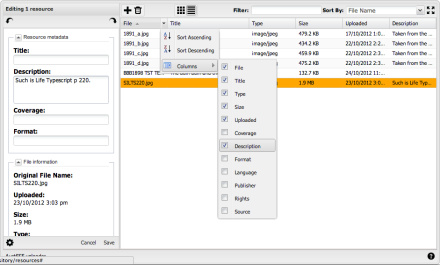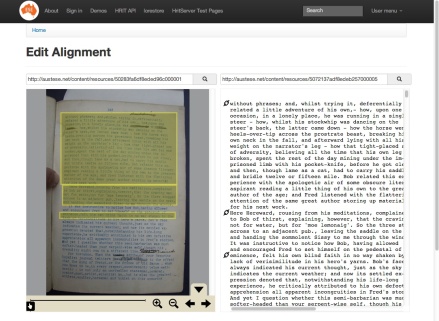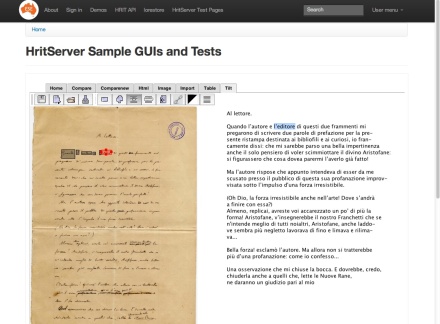The AustESE Project has recently passed the sixth month of development and the tools and workbench are starting to come together.
The project aims to support the necessary workflow for scholarly editing with an online workbench that employs a data model that identifies the entities and relationships that are often implicit in our discussions about literary works and scholarly editing. In addition to a simple Artefact/Version/Work/Agent ontology that helps to represent the material evidence, agency, and the conceptual properties that we attribute to that evidence, we are also exploring event modelling that will support the visualisation of timelines and other queries.
To achieve that in a reasonable timeframe, the project has begun to refine the foundational modules of the workbench.
Text and Image Upload and Description
A text and image upload facility supports the attachment of metadata to single files or to batches of files. It is here that the editor can assert the properties of the artefacts that they believe best describe the way those artefacts represent the work. Ultimately, this will support efficient navigation between images, transcriptions and agents and lay the foundation for the annotation service that will overlay the editor’s and/or reader’s commentary.

Text and Image Upload and Description
Text and Image Alignment
Two separate tools have been developed to support text and image alignment. One option builds on models developed for the Open Annotation Collaboration, offering an environment that enables manual linking between regions of an image and the related text of a transcription. Development of this tool has established the foundations for the annotation service and will be further developed to include the capability to draw polygons for more complicated documents when annotation receives more attention in 2013.

Annotation Alignment
Manual linking might not be a reasonable option for projects with large amounts of documents and so automation, or, at least, semi-automation, is an attractive option. Desmond Schmidt has developed a working model for automated text and image alignment and has a description of this development on his blog. Whether the links between text and image are created manually or automatically, they will add to the descriptions of artefacts, versions, and works to support more efficient navigation, discovery and querying. Such an environment will satisfy the archival impulse of a scholarly editing project and offer a dynamic space for editing and commentary to begin.

HRITServer Alignment
Versioning and Comparison
The next step in the project is to integrate these modules with a tool that will support comparison of versions by offering a variety of views and visualisations. The AustESE Project is employing Desmond Schmidt’s nMerge MVD to deliver innovative views that will assist both editors and readers to engage with the sometimes very complex variation between versions of literary works. Current views include side-by-side, top-bottom, and a text and table view. The project aims to add to these options with other views and visualisations that help to identify the temporal and spatial intensity of revision. We also aim to support the filtering of revision according to the contributions of authors, editors, compositors, and other agents of change.

Apparatus Table View
Next Steps
In the coming months, we will be working to refine these foundational modules and to enhance the integration of tools and data so that we can begin working on the case-studies that the AustESE Steering Committee has brought to the table. An electronic edition of Joseph Furphy’s Such is Life is underway, and Paul Eggert’s Harpur Critical Archive will also provide complex examples of textual transmission to test the tools and infrastructure. An AustESE workshop is planned for April 2013 at the University of Sydney, offering Australia’s scholarly editing community an opportunity to test and contribute to the workbench refinement in order to ensure that it is useful to the widest variety of editorial projects.
In 2013, the project will begin to integrate an annotation service. The workbench design will move between support for scholarly editing and support for readers who will benefit from greater access to the archive and the opportunity to contribute commentary, queries and corrections. This will be supported by work already done for the Open Annotation Collaboration, ensuring that the integration of these modules remains re-usable and interoperable well into the future.
If you would like more information, access to the project Sandbox, or directions to the code, please visit the Project Website.







